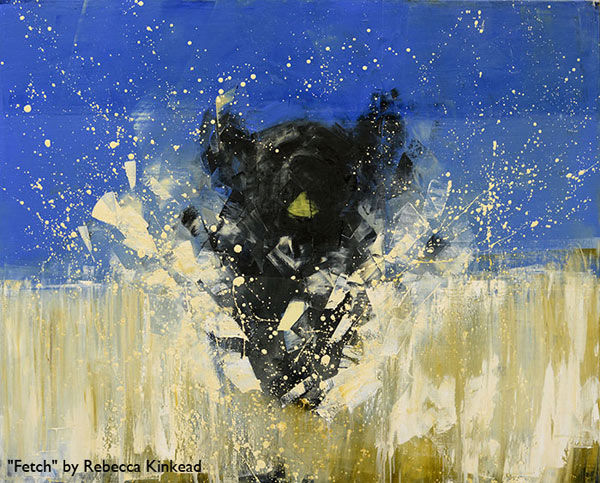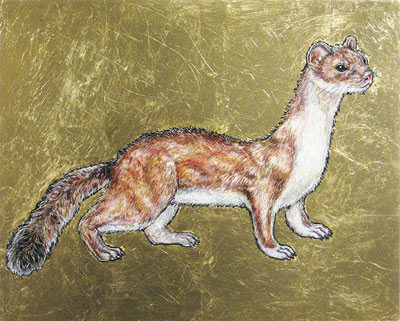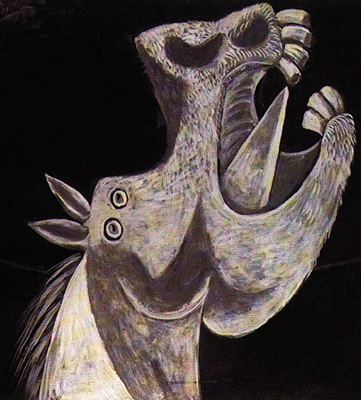
Thems is Us
There is not an animal on earth, or in our unearthly imaginations, that has not been endowed with human meaning beyond its perfect “is-ness.”
The reasons for this would fill a dissertation (or a courtroom) let alone a humble notebook entry.
Nevertheless, as an artist whose imagery leans heavily on their powers I need to honor the membership of animals in the pantheon of human deities, although I will only be scratching the surface.
Across the globe, across time and second only to our own likeness, image-makers have used animals as a mother lode of subject matter, probably because early on, if less so now, humanoids recognized that “Them’s Is Us.”
We use them as models because every aspect of an animal’s physical body reflects the fundamentals of our manifested reality: the curve, angle, point and spiral. Flesh and eyes and joints.
We depict them because they are ubiquitous, even if some of us have forgotten this.

“Weasel” by Elli Crocker
The artist Elli Crocker, whose majestic drawings of animals are an important part of her repertoire, has thought a lot about our relationship with them. In one sense, she says, we know more than ever about animals, all we have to do is Google a species and we can find out everything about them from their bone structure to their mating habits.
And yet “we’re perhaps more estranged than ever … Our comprehension of animal reality feels odd and imbalanced.”
They’ve always been emeshed in human life. “We’ve used animals for clothing and food. We eat, befriend, breed animals and kill them for sport. We bioengineer and clone them.”
And we perform experiments on them we wouldn’t do on ourselves. We excuse this by declaring they don’t think (like we do) don’t feel pain or fear (like we do).
It is a mighty paradox that we neglect, torture slaughter and dismiss the very beings we revere, study, save and conjure in dreams.
Why are we compelled to project onto an animal image qualities we fear and admire? In daily life animals in the wild may be flea-ridden, obsessive foodies but in our collective imagination we get immense spiritual gratification using them as receptacles of poetry.
Some of it has to do with the sheer size of some beasts, their strength, predatory danger and perceived intelligence.
Into those warrior-like male archetypes fall The Lion, The Stag, The Bear, The Bull, The Tiger, The Elephant, The Wolf, The Eagle. Even Pinocchio’s whale.
We have the calculating fox, cat, coyote, rat, serpent. The unifying dove, the prophetic raven. The sacrificial lamb. The fertilizing bee, the Resurrection Butterfly and resurrecting Phoenix. (Speaking of Phoenix, we’ve also breathed life into winged lions and uni-horned horses, fire-mouthed dragons, thunderbirds, and our own gap-filler, the mermaid.
We attribute special sacredness to nature’s rarities: The white whale, white buffalo, white leopard, black swan.
Perhaps we want to observe the fearful in a reflection outside of ourselves, and we want to absorb the noble by aligning ourselves with a “familiar.” Thus the totem, the fetish, the animal as spiritual lightning rod.
Maybe it’s Darwinism. By granting us our beloved sense of mystery some species have narrowly sidestepped extinction. Just a thought.
Animals provide allegory and metaphor, standing in for humans as in Mickey Mouse and Kafka’s cockroach. A friend once showed me a page from an ancient Hebrew Passover haggadah. Because Jewish people were not supposed to make human images it was illustrated with bird-headed people.
Ultimately for artists, animals are living, breathing grace, in motion and repose.
These days they are also fragile emissaries of a yet unbroken world, or, more accurately, canaries in the global coalmine.
Referring to artists as “mediums of our society,” Elli Crocker believes animal imagery is reappearing in contemporary art for contemporary reasons. The speeding changes in our global climate, she says, “puts the future of most species in incredible peril. We are beginning to experience a fraught sense of this shared destiny tied in with all life on the planet.”
Animal as warning. The one true thing we have in common with animals is mortality.
Featured image by Rebecca Kinkead




